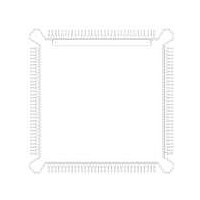MC68HC16Z1CEH16 Freescale Semiconductor, MC68HC16Z1CEH16 Datasheet - Page 230

MC68HC16Z1CEH16
Manufacturer Part Number
MC68HC16Z1CEH16
Description
IC MCU 16BIT 16MHZ 132-PQFP
Manufacturer
Freescale Semiconductor
Series
HC16r
Specifications of MC68HC16Z1CEH16
Core Processor
CPU16
Core Size
16-Bit
Speed
16MHz
Connectivity
EBI/EMI, SCI, SPI
Peripherals
POR, PWM, WDT
Number Of I /o
16
Program Memory Type
ROMless
Ram Size
1K x 8
Voltage - Supply (vcc/vdd)
2.7 V ~ 5.5 V
Data Converters
A/D 8x10b
Oscillator Type
Internal
Operating Temperature
-40°C ~ 85°C
Package / Case
132-QFP
Processor Series
HC16Z
Core
CPU16
Data Bus Width
16 bit
Controller Family/series
68HC16
No. Of I/o's
26
Ram Memory Size
1KB
Cpu Speed
16MHz
No. Of Timers
2
Embedded Interface Type
QSPI, SCI
Rohs Compliant
Yes
Package
132PQFP
Family Name
HC16
Maximum Speed
16 MHz
Operating Supply Voltage
3.3|5 V
Number Of Programmable I/os
16
On-chip Adc
8-chx10-bit
Number Of Timers
11
Data Ram Size
1 KB
Interface Type
SCI, SPI, UART
Maximum Clock Frequency
16 MHz
Maximum Operating Temperature
+ 85 C
Mounting Style
SMD/SMT
Minimum Operating Temperature
- 40 C
Lead Free Status / RoHS Status
Lead free / RoHS Compliant
Eeprom Size
-
Program Memory Size
-
Lead Free Status / Rohs Status
Lead free / RoHS Compliant
Available stocks
Company
Part Number
Manufacturer
Quantity
Price
Company:
Part Number:
MC68HC16Z1CEH16
Manufacturer:
Freescale Semiconductor
Quantity:
10 000
Part Number:
MC68HC16Z1CEH16
Manufacturer:
FREESCALE
Quantity:
20 000
- Current page: 230 of 500
- Download datasheet (6Mb)
9.3.5.3 Slave Mode
9-20
Clearing the MSTR bit in SPCR0 selects slave mode operation. In slave mode, the
QSPI is unable to initiate serial transfers. Transfers are initiated by an external SPI bus
master. Slave mode is typically used on a multi-master SPI bus. Only one device can
be bus master (operate in master mode) at any given time.
Before QSPI operation is initiated, QSM register PQSPAR must be written to assign
necessary pins to the QSPI. The pins necessary for slave mode operation are MISO,
MOSI, SCK, and PCS0/SS. MISO is used for serial data output in slave mode, and
MOSI is used for serial data input. Either or both may be necessary, depending on the
particular application. SCK is the serial clock input in slave mode and must be as-
signed to the QSPI for proper operation. Assertion of the active-low slave select signal
(SS) initiates slave mode operation.
Before slave mode operation is initiated, DDRQS must be written to direct data flow
on the QSPI pins used. Configure the MOSI, SCK and PCS0/SS pins as inputs. The
MISO pin must be configured as an output.
After pins are assigned and configured, write data to be transmitted into transmit RAM.
Command RAM is not used in slave mode, and does not need to be initialized. Set the
queue pointers, as appropriate.
When SPE is set and MSTR is clear, a low state on the slave select PCS0/SS pin be-
gins slave mode operation at the address indicated by NEWQP. Data that is received
is stored at the pointer address in receive RAM. Data is simultaneously loaded into the
data serializer from the pointer address in transmit RAM and transmitted. Transfer is
synchronized with the externally generated SCK. The CPHA and CPOL bits determine
upon which SCK edge to latch incoming data from the MISO pin and to drive outgoing
data from the MOSI pin.
Because the command RAM is not used in slave mode, the CONT, BITSE, DT, DSCK,
and peripheral chip-select bits have no effect. The PCS0/SS pin is used only as an in-
put.
The SPBR, DT and DSCKL fields in SPCR0 and SPCR1 bits are not used in slave
mode. The QSPI drives neither the clock nor the chip-select pins and thus cannot con-
trol clock rate or transfer delay.
Because the BITSE option is not available in slave mode, the BITS field in SPCR0
specifies the number of bits to be transferred for all transfers in the queue. When the
number of bits designated by BITS[3:0] has been transferred, the QSPI stores the
working queue pointer value in CPTQP, increments the working queue pointer, and
loads new transmit data from transmit RAM into the data serializer. The working queue
pointer address is used the next time PCS0/SS is asserted, unless the CPU16 writes
to NEWQP first.
The QSPI shifts one bit for each pulse of SCK until the slave select input goes high. If
SS goes high before the number of bits specified by the BITS field is transferred, the
QSPI resumes operation at the same pointer address the next time SS is asserted.
The maximum value that the BITS field can have is 16. If more than 16 bits are trans-
mitted before SS is negated, pointers are incremented and operation continues.
Freescale Semiconductor, Inc.
For More Information On This Product,
QUEUED SERIAL MODULE
Go to: www.freescale.com
M68HC16 Z SERIES
USER’S MANUAL
Related parts for MC68HC16Z1CEH16
Image
Part Number
Description
Manufacturer
Datasheet
Request
R
Part Number:
Description:
Manufacturer:
Freescale Semiconductor, Inc
Datasheet:
Part Number:
Description:
Manufacturer:
Freescale Semiconductor, Inc
Datasheet:
Part Number:
Description:
Manufacturer:
Freescale Semiconductor, Inc
Datasheet:
Part Number:
Description:
Manufacturer:
Freescale Semiconductor, Inc
Datasheet:
Part Number:
Description:
Manufacturer:
Freescale Semiconductor, Inc
Datasheet:
Part Number:
Description:
Manufacturer:
Freescale Semiconductor, Inc
Datasheet:
Part Number:
Description:
Manufacturer:
Freescale Semiconductor, Inc
Datasheet:
Part Number:
Description:
Manufacturer:
Freescale Semiconductor, Inc
Datasheet:
Part Number:
Description:
Manufacturer:
Freescale Semiconductor, Inc
Datasheet:
Part Number:
Description:
Manufacturer:
Freescale Semiconductor, Inc
Datasheet:
Part Number:
Description:
Manufacturer:
Freescale Semiconductor, Inc
Datasheet:
Part Number:
Description:
Manufacturer:
Freescale Semiconductor, Inc
Datasheet:
Part Number:
Description:
Manufacturer:
Freescale Semiconductor, Inc
Datasheet:
Part Number:
Description:
Manufacturer:
Freescale Semiconductor, Inc
Datasheet:
Part Number:
Description:
Manufacturer:
Freescale Semiconductor, Inc
Datasheet:











